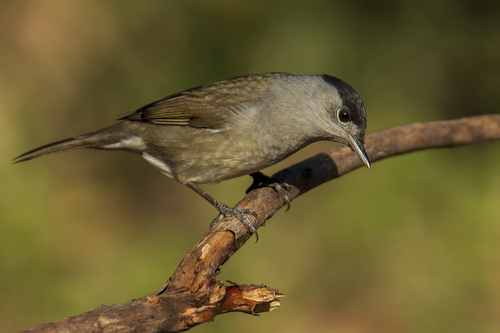
Eurasian Blackcap
The Eurasian Blackcap (*Sylvia atricapilla*) is a widespread and adaptable warbler known for its melodious song and, in males, distinctive black cap. It plays a significant role in seed dispersal and insect control within its varied habitats. While not globally threatened, localized populations face challenges from habitat loss and climate change. The Blackcap has some cultural significance, often appearing in European folklore and literature, usually symbolizing spring and renewal due to its return from migration.
13-15 cm
Length
20-23 cm
Wingspan
Least Concern
Conservation Status
Distribution
The Eurasian Blackcap breeds across most of Europe, extending into western Asia and parts of North Africa. It is a migratory species, with most populations wintering in southern Europe, North Africa, and sub-Saharan Africa. Some populations are resident year-round, particularly in milder western European regions. Altitudinal range varies from sea level to montane forests.
Lifespan
Typically 2-5 years in the wild, but can reach up to 10 years.
Eurasian Blackcap's Habitat
Habitat Types
Woodlands, Forest edges, Hedgerows, Gardens, Scrubland, Parks
Climate Zones
Temperate, Mediterranean, Boreal
Adaptations
The Blackcap's relatively broad diet and tolerance of a range of habitats contribute to its wide distribution. Its slender bill is well-suited for gleaning insects from foliage and consuming small fruits.
Variations
Several subspecies are recognized, differing slightly in plumage coloration and size. For example, *S. a. heineken* found in Iberia and North Africa tends to have darker plumage.
Appearance
Breeding Plumage
Males have a distinctive black cap during the breeding season, while females and juveniles have a reddish-brown cap. The overall plumage is gray-brown above and paler below.
Seasonal Feather Changes
Plumage is generally brighter during the breeding season and slightly duller in the non-breeding season.
Sex Based Plumage Differences
Significant; males have a black cap, females a reddish-brown cap.
Notable Features
Black or reddish-brown cap (depending on sex), Slender, pointed bill, Gray-brown upperparts, Pale underparts
Diet and Feeding
Primary Foods
Insects, Spiders, Berries, Small fruits
Foraging Behavior
The Blackcap actively forages in trees and shrubs, gleaning insects from leaves and branches. It also hovers briefly to pick berries and fruits.
Specializations
Its slender bill is adapted for both insect capture and fruit consumption. It can switch between these food sources depending on availability.
Seasonal Diet Variations
During the breeding season, the diet is primarily insects, providing protein for growing chicks. In autumn and winter, the diet shifts to berries and fruits, providing energy for migration and survival.
Behavior
Social Structure
Generally solitary or in pairs during the breeding season. May form small flocks during migration and in wintering areas.
Communication
Melodious, fluting song (used by males to defend territory and attract mates), Chattering calls, Soft 'tec' contact calls
Migration
Most populations are migratory, undertaking long-distance journeys between breeding and wintering grounds. Some populations, particularly in western Europe, are partial migrants or resident.
Territorial or Group Behaviors
Males are highly territorial during the breeding season, defending their territory with song and aggressive displays. Outside the breeding season, they are less territorial and may form loose flocks.
Conservation
Threats
Habitat loss (due to deforestation and agricultural intensification), Climate change (affecting breeding and migration patterns), Pesticide use (reducing insect prey availability), Collisions with buildings and other structures
Protection Programs
Habitat restoration and management, Monitoring programs, Awareness campaigns
Local National Laws
Protected under various national and international wildlife legislation, such as the EU Birds Directive.
Population Trend
Stable
Population Estimates
Estimated global population of 114,000,000-199,000,000 mature individuals.
Interesting Facts
Blackcaps are known for their ability to mimic other birds' songs.
This mimicry is thought to be part of their complex vocal repertoire, used in territorial defense and mate attraction.
Some Blackcaps have changed their migratory routes in recent decades.
This shift is linked to climate change and the availability of food in gardens in western Europe.
They can rapidly digest fruit, passing seeds within an hour.
This makes them important seed dispersers for many plant species.
Faqs about Eurasian Blackcap
What is the difference between a male and female Blackcap?
Males have a black cap, while females have a reddish-brown cap.
Where do Blackcaps migrate to?
Most populations migrate to southern Europe, North Africa, and sub-Saharan Africa for the winter.
What do Blackcaps eat?
They eat insects, spiders, berries, and small fruits.
Are Blackcaps endangered?
No, they are classified as Least Concern by the IUCN.
Copyright @ Nature Style Limited. All Rights Reserved.
 English
English